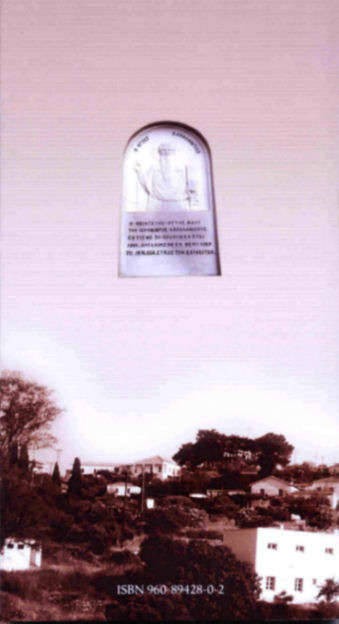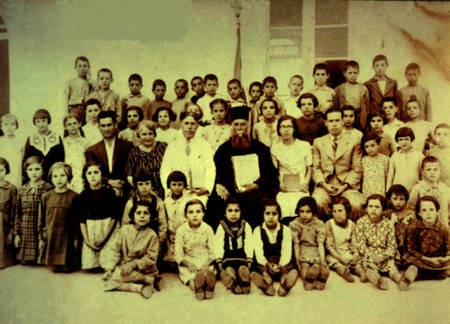Karavitiko Symposium, Sydney.
Karavitiko Symposium
42 Eastern Avenue
Dover Heights. 2030
Sydney. NSW.
Australia.
02 93888320
Contact the Karavitiko Symposium, Sydney here
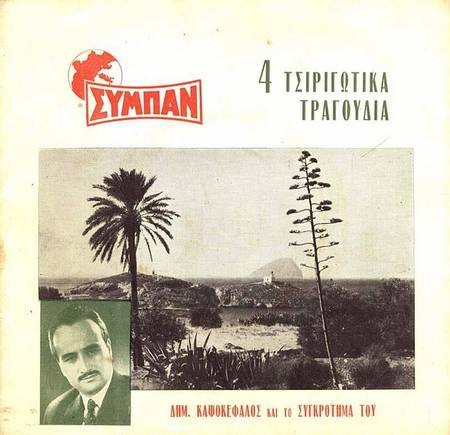
Coat of Arms of the Karavitiko Symposium. Designed by Lindsay Katharos Crethar of Lindsay Crethar Graphic Design, Berry, NSW.

Official flag of the Karavitiko Symposium.
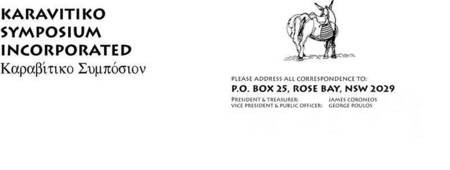 Letterhead of the Karavitiko Symposium.
Letterhead of the Karavitiko Symposium.
Administrators, 2005.
President:
George C Hlihlis Poulos
Committee:
Secretary:
Peter S Kapitanios Poulos
Treasurer:
Theo S Kapitanios Poulos
Patron: Angelo Chouli Kritharis
Matron: Matty Kapitanios Venardos
Past Patrons & Matrons:
Jack Vanges
Louisa Psaltis
Petros Coroneos
James Coroneos
Committee of the Karavitiko Symposium.
Recent Committees of the Karavitiko Symposium
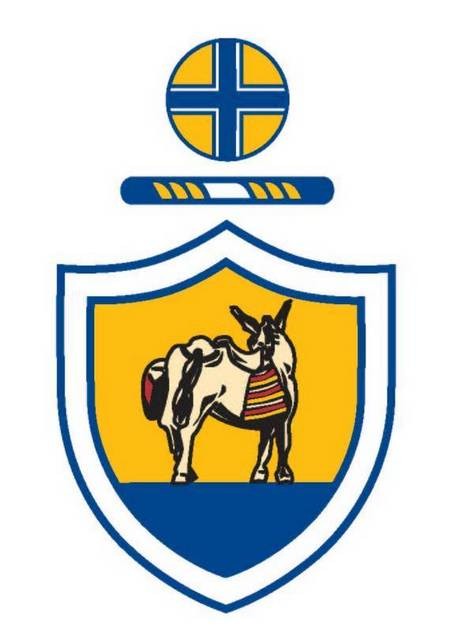
Year 2000 Committee.
Left to right: Theo Kapetanios Poulos, Andy Psomas Coroneos, Guest of Honour, 2000, George Layos Souris, James Melosophaos Coroneos, George Hlihlis Poulos, Nick Datos, and Tanya Datos.
History of the establishment of the town of Karavas. (In Greek)
The first Kytherian immigrant to Australia was a Karaviti! Emmanuel Kritharis
The feast day of Ayios Haralambos
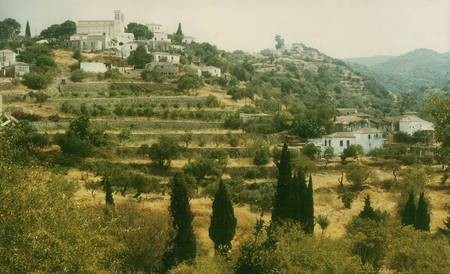
The Feast Day of Ayios Haralambos is celebrated on the 10th February, each year.
Tragic life-history of Ayios Haralambos
Longer summaries of the life of Saint Haralambos in English are available in
'Lives of Saints' Vol. 13, published by:
'The Archangel Michael Orthodox Mission', P.O. Box 554,
Marrickville, Sydney
Australia, or in,
'Living Orthodoxy', Vol.13 published by
'The Saint John of Kronstadt Press',
1180, Orthodox Way,
Liberty, TN37095,
USA.
History of the Karavitiko
The first Symposium was instigated in 1967. It has been conducted every year since. The Symposium was designed to perpetuate the enormous panayiri that was held annually in Karavas to celebrate the name day of the patron saint of the village - Ayios Haralambos.
A formal luncheon or dinner is organised for the first Sunday after Ayios Hralambos's feast day. The Symposium organisers lay claim to the fact that "..we are the only Kytherian village group anywhere in the world who have managed to maintain this tradition in this formal manner". Are there other village groups in the world who also formally celebrate the feast day of their patron saint in this way?
Initially profits from the function were sent back to Karavas to keep the Church of Ayios Haralambos in good order.
We are very thankful for the magnificent support over 30 years of the following Karavites. Louisa Psaltis, patron for many years, Jack Vanges, Lillian Vanges, Charles Cominos, Lackey Poulos, Olga N. Kastrisios (nee, Coroneos) and James Coroneos.
1997 saw the retirement from active involvement of Petros Coroneos, one of the Founding Father’s of the Karavitiko Symposium. Petros devoted himself for more than 30 years to perpetuating the event. The Committee would like to thank Petros for 30 years of devoted and dedicated effort, in enhancing the reputation of “…our own special domain, our very own haven…”, KARAVAS. Without Petros’s constant encouragement, the Karavitiko Symposium may have ceased years ago.
Petros died soon after retiring from the Committee.
Subsequent long-standing President, James Coroneos, died in 2005.
James Coroneos, Obituary
Pride in Karavas
From:
http://www.mykythera.gr/en/whattosee/villages.php
"What can you say about the village. Located in the northern part of island, near Potamos. Green-clad place. Abundant water is ceaselessly running in the dells. The springs of Amir Ali, caress your senses and refresh your heart. The architecture of the village is the highlight. Splendid buildings and houses with a particular identity. The residents of Karavas are proud of the collective activity that they have developed. The local association, "Portokalia" from the homonym holy tree of the village (orange tree), organises many cultural events, mainly in the summertime. Surely if you know a Karaviti you'll be impressed by his/her love for the village".
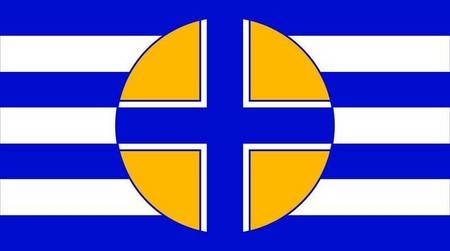
Karavas, with the Chuch of Ayios Haralambos as its centrepiece.
The Feast Day of Ayios Haralambos is celebrated on the 10th February.
Traditionally, a formal luncheon or dinner, organised by the Karavitiko Symposium, has been celebrated in Sydney, on the first Sunday, after the 10th February, each year.
The life of Ayios Haralambos has been recounted at some length in Culture, subsection, Religion, and can also be accessed by using the internal search engine, under Haralambos.
Book Outlining the History of the Church of Ayios Haralambos.
Author: Helen Haros-Coroneos
When Published: 2006
Publisher: Church Committee, Ayios Haralambos, Karavas, Kythera.
Printed: in Crete, www.kazanakis.gr
Available:
Description: Thin, small, 78 page book. Excellent photographs.
Language: GREEK.
Celebrating the Bicentennary of the creation of the fraternity that led to the building of the Church of Ayios Haralambos, Karavas, Kythera.
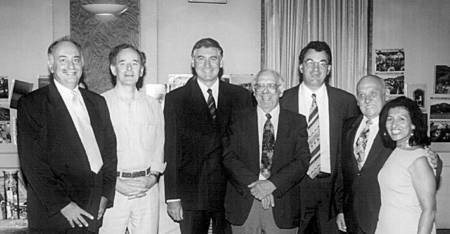
Front Page.
Prologue and Introduction in English. (Grammar and syntax errors retained).
P R 0 L 0 G U E
In the verdant picturesque and beautiful village of Kythera which is named Karavas, well known for its orange trees, its many springs and natural beauties as well as for its panoramic view to the island of Elafonissos and to the small city of Neapoli in the south of Peloponnisos, the historic majestic and imposing holy temple of Saint Charalampos surely dominates and has a principal position on this surrounding.
For a series of generations for the people of Karavas this temple has been a reference point and holy place from which life started, but, on the other hand the terrestrial life of these people ended. For the sad and for the good moments to the happy and unhappy personal family, social and national events the pious gentle and progressive people of Karavas considered and still do, after God and Virgin Mary, the temple of Saint Charalampos as their guardian and helper, something that they show by the beautiful fine and well looked after interior and exterior decoration of the holy temple where a lot of local festival and a number of happenings are held around it.
The assemblance and the recording of this rich historic material concerning the church of Saint Charalampos of Karavas and the writing of this book from the honourable Mrs Helen Haros-Coroneos an exceptional philologist and teacher of the Greek language, but also one of the greatest spiritual people of Kythera, constitutes for Caravas as well as for the island which belongs to Panayia Myrtidiotissa a notable and worth of congratulations event.
I consider it as my duty to deeply congratulate the active and constantly creative dean of the holy temple of Saint Charalampos father Panayiotis Diacopoulos and his progressive council of church for this initiation and impeccable collaboration with Mrs Haros.
Finally I paternally and whole heartedly wish that this book will help and contribute to the spiritual, cultural and touristic development of Cythera as there are a lot of primary needs that should be developed.
With warm fatherly wishes wholehearted congratulations and all my love.
The Bishop of Thessaliotidos
and Fanariofersallon
Cirillos (ex of Cythera)
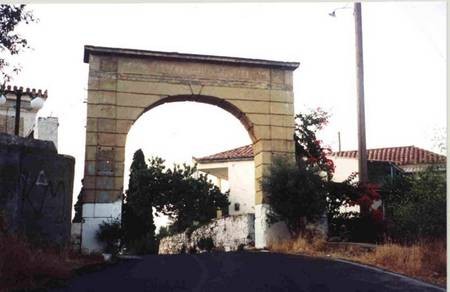
Back Cover.
I N T R 0 D U C T I 0 N
The completion of two centuries from the creation of the fraternity of Saint Charalampos in Caravas and the foundation of the homonymous temple was the tinder for the writing of this small essay.
It is well known that almost all the temples in Cythera were built by individuals and were used as family ones. A small number of temples were built by fraternities for the worship needs of their members such as the temple of Panayia Conteletou in Livadi, Saint Annas temple in Chora and Saint Charalambos in Caravas
It is easy to understand that the foundation of a temple from a fraternity in a remote village in Cythera 200 years ago has a major religious as well as social importance. The bond between the members of the fraternity, the harmonious collaboration and the noble emulation for the foundation and the distinction of their temple is a phenomenon worth to pay attention to and to be studied.
Beyond these, the formation of the fraternity and the foundation of the temple in Caravas introduces a great historic interest for the synthesis of the population and it also coincides with the period of huge political changes and the large movements of the population in Cythera.
The aim of this essay, even though there are a lot of imperfections for which I ask for your indulgence, is to shed light on the most beautiful period of the history of Caravas which is bound with the first years of the formation of the well organized settlements.
I owe a lot of thanks not only to the priest from Caravas, father Panayotis Diacopoulos for his valuable cooperation but also to the exceptional scientist and friend Manolis Dracacis, head of department of the General State Archives of the Heraclion, for his unquestionable willingness to assist me, his most important remarks as well as his valuable advice, which have improved the contents of the book. Finally, I thank the head of department of the Local Archives of Cythera Michael Megaloconomos, for its support in this effort that we've managed to accomplish, and Valerios Kalocherinos for the photo’s in this edition.
Helen Haros-Coroneos
Philologist of Local Archives of Cythera
Karavas' most famous priest
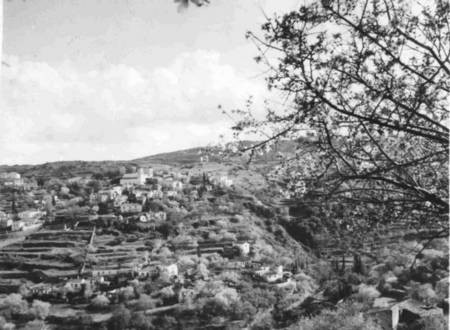
Pappa Vangelli, and his wife Stamatia, (nee, Panaretos). Pappa Vangelli as a young priest.
Pappa Vangelli, and his wife Stamatia
Edited version of Father Evangelos Crithary the priest of Karavas and his wife Stamatia (nee Panaretos), with the damage to the photograph removed
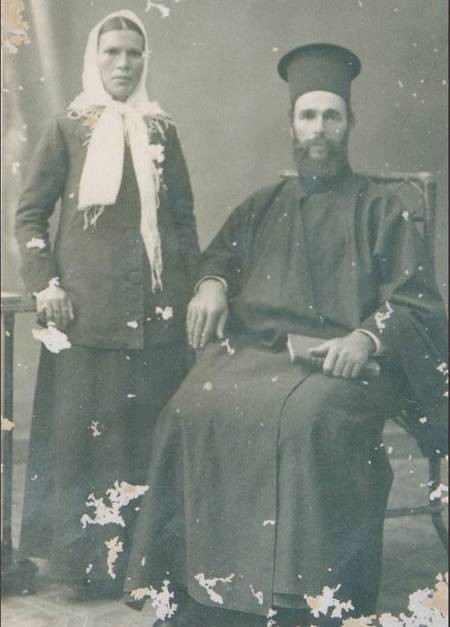
Pappa Vangelli, centre, was both the village priest of Karavas, and the Headmaster of the school. Photograph taken, 1938.
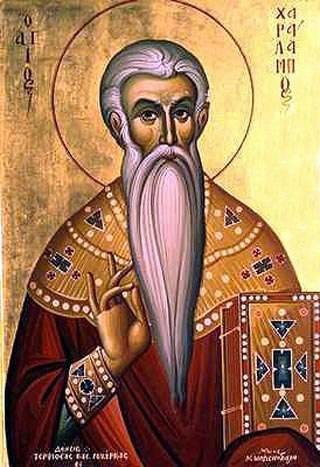
Karavas in its prime in the 1950's. The magnificent white blossoms of the Almond trees signify that the feast day of the Saint of the Village of Karavas is not far away.
Many older Karavites recall the beauty of almond blossoms, with an almost reverential tone. In the novel Report to Greco, Nikos Kazantzakis equates the blossoming of an almond tree, with a sign from God.
The relevant passage reads:
"As I turn over the yellowed pages of my journal, it becomes clear that nothing died. Everything was simply asleep inside me. Look how all has awakened now, how everything rises from the worn, half-indecipherable pages to become monasteries, monks, paintings, and the sea once more! And my friend, he too rises from the soil as he was at that time, handsome, in the flower of youth, with his Homeric laugh, his blue eagle-eye, his breast filled with poems! He gave men more than they were able to receive, he sought from them more than they were able to give, and he died forsaken and sorrowful, having been left with nothing but the bitter smile of a proud, wounded soul. A meteor, he conquered the darkness for an instant and then perished. Such is the way we all shall perish, such the way the earth too will perish; but this fact offers no consolation, nor is it any justification for He who begets and then destroys us.
We had toured the Holy Mountain for forty days. When, completing our circle, we finally returned to Daphne on Christmas Eve in order to depart, the most unexpected, most decisive miracle was awaiting us. Though it was the heart of winter, there in a small, humble orchard was an almond tree in bloom!
Seizing my friend’s arm, I pointed to the blossoming tree.
“Angelos,” I said, “during the whole of this pilgrimage our
hearts have been tormented by many intricate questions. Now, behold the answer!”
My friend riveted his blue eyes upon the flowering almond tree and crossed himself, as though doing obeisance before a holy wonder-working icon. He remained speechless for a long moment. Then, speaking slowly, he said, “A poem is rising to my lips, a tiny little poem: a haikai.”
He looked again at the almond tree.
I said to the almond tree, “Sister, speak to me of God.” And the almond tree blossomed."
Speak to a Karaviti of God - and the almond tree blossoms.
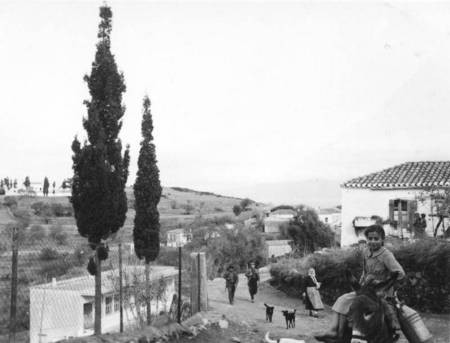
Vintage postcard from the 1950's(?), of Karavas, looking North, with the Patrikios Agricultural School in the background.
The young girl on the donkey is - Matina Cominos (nee, Zantiotis) - Sarandakos.
The Natural Springs
One of the most dynamic geological features of Kythera generally, and particularly the village of Karavas, is the large number of natural springs.
The three springs in central Karavas - at Keramari, Amir Ali, and Portakalia, run perpetually.
The water from those springs is exceptionally beautiful to drink. As my parents have been fond of telling me throughout my lifetime - "then vluffi" - it doesn't matter how much you drink, the water never makes you "feel full."
It is important to try to understand how these springs may have come into existence.
Kevin Sparkman of FloridaSprings Organisation has kindly given us permission to utilise his explanation as to how the abundant springs in Florida, USA have evolved. Many of the evolutionary principles outlined on the FloridaSprings website
www.FloridaSprings.org
will pertain to the evolution of the many springs on Kythera, and in Karavas.
The Geology of Natural Springs
Karavas, reknown for its natural springs
The natural Spring at Keramari
Water from the spring at Amir Ali
The longer view of the spring at Amir Ali
The Built Environment
There are many interesting structures in and around Karavas. As well as the Church of Ayios Haralambos, and the various springs which are mentioned elsewhere, these include the Entry Arch, the Patrikios Scholio, the Palio Scholio, the ruins at Mavroyoryanika, the terraces of Karavas; amongst others.
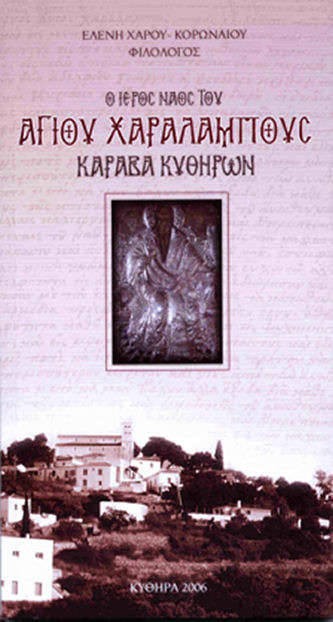
The famous Entrance Arch or apsitha to Karavas.
The terraces of Karavas
Patrikios Scholio, Karavas
Houses in ruins, Mavroyoryanika, Karavas
Portakalia Tou Karava. One of the abiding myths of Karavas surrounds a massive orange tree, located near the mill, at present-day Portakalia springs. In fruit, it was said to provide the villagers of Karavas with an almost endless supply of large juicy oranges. Some background to the myth is provided in Haralambos E Kritheris book Kytheraika Afiyimata, (In Greek). [See Culture, subsection Bibliography, for further details about this book.] According to Kritheris, the tree withered and died, a few years before 1864.
The importance of Vitamin C to a population with a limited food supply cannot be overestimated. On Wednesday, Dec 3, 2003, Sydney's Daily Telegraph, page 7, reported that "scientists have identified a key to preventing serious illnesses including cancer, heart disease and stroke - eating an extra orange a day.
Eating citrus fruits cuts the risk of some cancers by up to 50% and reduces the chance of stroke by almost 20%, say reseachers at the CSIRO.
Dr Katrine Baghurst, head of the CSIRO health sciences and nutrition consumer science program, reviewed almost 50 studies on the protective effects of citrus fruits.
She said: "Citrus fruits contain a powerful combination of nutrients and bioactive phyto-chemicals which protect the body through antioxidant properties and by strengthening the immune system, inhibiting tumour growth and normalising tumour cells.
"There is strong evidence to show these attributes can reduce the risk of cancer of the mouth, larynx, pharynx and stomach by 40-50"", Dr Baghurst said.
Oranges have the highest level of antioxidants in all fruit".
Vitamin C was used by Kytherian Archie Kalokerinos to combat the effect of toxins in the gut amongst Aboriginal children. By this means he was able to save the lives of many indigenous Australian children. (See numerous articles on Archie Kalokerinos at kythera-family.net. Dual Nobel laureate, and good friend of Archie's, Linus Pauling, did much to promote the benefits of Vitamin C in the twentieth century.
Portakalia Tou Karava - the Karavas Village Anthem.
The song about this "mythical" tree, Portakalia Tou Karava consitutes the Karavas Village anthem. Courtesy of Petro Cassimaty, Kensington, Australia:
Listen to, or, download the Karavas Village Anthem to your computer
The record cover from a recording of the song Portokalia Tou Karava, sung by Dimitri Kapsokefalos.
